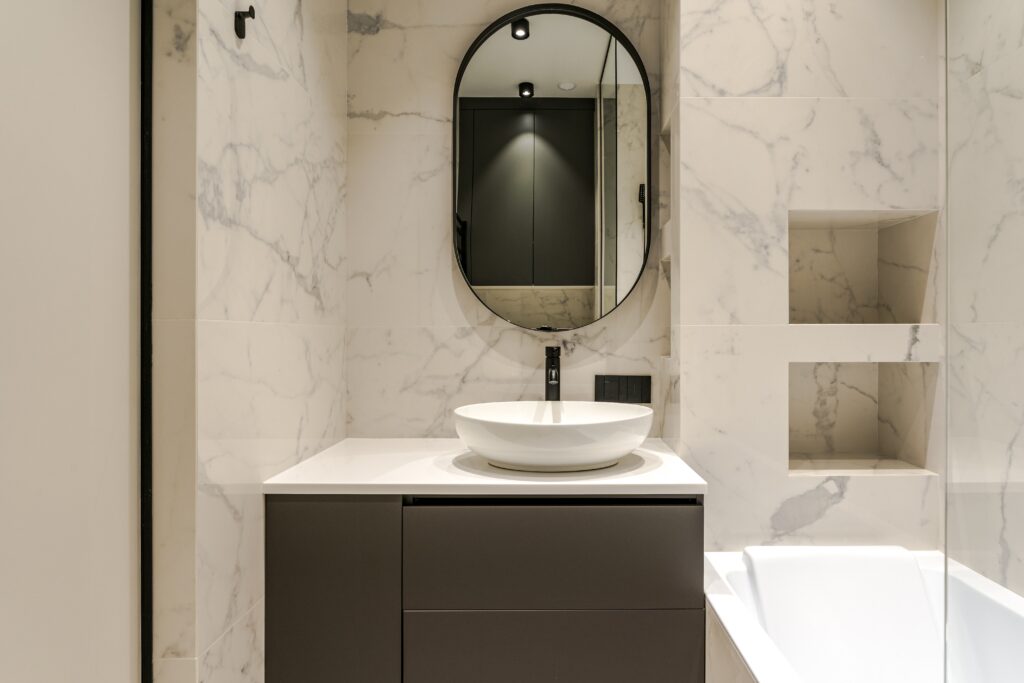Tips for Shower Design in a Small Bathroom

Designing a small bathroom can feel like a puzzle—but with the right pieces, it all comes together beautifully. Limited space means every choice counts, especially when it comes to the shower.
The good news? A well-planned shower design can make your bathroom feel bigger, function better, and still look amazing.
From choosing the right layout and materials to finding clever ways to boost storage, your shower can do a lot of heavy lifting in a small space. Whether you’re updating an existing setup or starting fresh, these tips will help you make smart design decisions without sacrificing comfort or style.
Table of Contents
Choose the Right Shower Type
When space is limited, picking the right shower style can make a huge difference—not just in how your bathroom looks, but in how it works for your daily routine.
Corner Showers are a classic go-to for small bathrooms. Tucked neatly into a corner, they free up valuable floor space while still giving you plenty of room to move around inside. They’re compact, practical, and come in all kinds of styles—from sleek modern glass to tiled enclosures.
Walk-in Showers are another great option, especially if you’re going for a more open, airy vibe. Since they don’t have bulky doors or raised edges, they help your bathroom feel bigger and less cramped. Plus, they’re easy to clean and great for anyone who wants a low-maintenance setup.
Curbless Showers take that open feel to the next level. With no step or threshold to cross, your flooring flows straight into the shower, making the whole room feel more seamless and spacious. It’s a sleek, modern look—and as a bonus, it’s super accessible and future-friendly too.
Choosing the right type of shower is the foundation for making a small bathroom feel larger, more functional, and totally stylish.
Go for Glass
When you’re designing a small bathroom, keeping things open and airy is key—and glass can help you do just that. Glass shower enclosures are a game-changer for making a tight space feel bigger, brighter, and more modern.
Frameless glass enclosures are especially great in small bathrooms. Without bulky metal framing, the glass practically disappears, letting your eyes take in the full room without visual interruption. It creates a sleek, high-end look and helps your bathroom feel more open and less boxed in.
Wondering whether to go with clear or frosted glass? Clear glass helps to maximize light and give the illusion of more space. It keeps everything looking wide open. Frosted glass, on the other hand, offers a bit more privacy—perfect if the bathroom is shared or if you just like a little more separation.
Now let’s talk about doors. Sliding glass doors are a solid pick when you don’t have much space to swing a door open. They glide along a track, making them ideal for narrow bathrooms. Hinged doors, while classic and sturdy, do require more clearance to open—so they work better in layouts where you’ve got the room. Think about your floor plan and how much space you really have to move around before deciding.
Use Light Colors and Reflective Surfaces
If you’re trying to make a small bathroom feel bigger and brighter, light colors and shiny surfaces will do the trick. These simple design hacks can totally transform how open your space feels, without needing to knock down any walls.
Start with your tile choices. Light-colored tiles—think soft whites, warm creams, pale grays, or even pastel blues—instantly make a room feel more airy and spacious. They reflect more light and give your bathroom a fresh, clean vibe. Glossy finishes are especially helpful here because they bounce light around the room, making everything look brighter.
Mirrors are another small-space essential. A large mirror over the vanity—or even a full wall mirror—can double the visual space in your bathroom. It reflects both natural and artificial light and makes the room feel more open.
Don’t forget about glossy surfaces in other places too, like countertops or high-sheen paint. Even small touches, like a shiny soap dish or reflective hardware, can add to the effect. When you combine light colors with reflective materials, you’re basically giving your small bathroom its own glow-up.
Built-In Storage Solutions
In a small bathroom, smart storage is everything—and the key is finding ways to add storage without adding clutter. That’s where built-in solutions really shine. They keep your shower essentials handy without taking up precious floor or wall space.
Start with shower niches. These little recessed shelves built right into the shower wall are a total game-changer. They’re sleek, customizable, and perfect for storing shampoo, soap, razors, and more—without the need for a clunky shower caddy. You can even tile them to match or contrast with the rest of your shower for a stylish touch.
Corner shelving or corner caddies are another great option, especially if you’re working with a tight layout. Since corners are often underused, adding a few built-in shelves there helps you make the most of every inch. And if you’re going for a clean, modern look, recessed units offer storage without anything sticking out.
The big thing to avoid? Bulky organizers that hang awkwardly over the showerhead or clutter up the floor. While they might be functional, they can make your bathroom feel cramped and chaotic. Built-in storage keeps everything looking tidy, open, and intentional—which is exactly what you want in a smaller space.
Tile and Layout Tips
Tile plays a huge role in how your small bathroom looks and feels—so choosing the right size, pattern, and layout can make a big difference.
Let’s start with the question: large tiles or small tiles? While it might seem like small tiles would make sense in a small space, they can actually make the room feel more crowded because of all the grout lines. Larger tiles, on the other hand, create a more seamless look with fewer lines breaking up the space. They can help the bathroom feel more open and less busy, especially when used on the walls or floors.
If you want to add a little personality and style, consider using vertical patterns or accent walls. Laying tiles vertically can draw the eye upward, making the ceiling feel higher and the room feel taller. An accent wall is a great way to bring in color, texture, or pattern without overwhelming the space. Think bold tile shapes, subtle geometric patterns, or a pop of color that complements the rest of the room.
As a general rule of thumb, go for continuous flooring whenever possible. Using the same tile across the bathroom floor creates a smooth, uninterrupted flow that visually stretches the space. It’s a simple trick that can make a small bathroom feel more cohesive and a lot more spacious.
Maximize Lighting
Lighting can make or break a small bathroom. The right setup doesn’t just help you see better—it can completely change how big and inviting the space feels. So if your bathroom feels a little dark or closed in, boosting your lighting is a great place to start.
If you’re lucky enough to have natural light, lean into it! A window—especially one with frosted glass—lets sunlight pour in while still giving you privacy. And if you’re doing a bigger renovation, adding a skylight is a beautiful way to bring in even more light without sacrificing wall space. It instantly opens up the room and makes it feel airy and fresh.
Inside the shower, don’t forget about recessed lighting. It’s subtle, modern, and doesn’t take up any headspace—perfect for low ceilings or tight corners. Plus, it ensures you’re not showering in the dark, which is never fun.
For extra brightness without cluttering your counters, try wall-mounted fixtures that are sleek and space-saving. Sconces on either side of the mirror are great for even lighting. Look for designs that sit close to the wall and have a streamlined look.
Good lighting doesn’t just make your bathroom look better—it makes it feel better, too. And in a small space, every bit of brightness helps.
Think About Accessibility
Even if you’re not planning a full-on aging-in-place bathroom right now, it’s smart to design with the future (and all types of users) in mind. Accessibility features don’t have to scream “hospital”—they can blend right in with your style while making your bathroom safer and more comfortable for everyone.
Grab bars, for example, are super helpful for stability—especially in the shower or near the toilet. These days, you can find stylish options that look more like towel bars or modern rails, so you don’t have to sacrifice aesthetics for function.
Non-slip flooring is another must in small bathrooms, where a single splash can make the whole floor slippery. Look for tiles with a bit of texture or a matte finish to give you that extra grip. It’s a simple way to add peace of mind without changing the look of your space.
If you’re doing a remodel, consider ADA-friendly layouts that allow for easy movement. Things like wider doorways, curbless walk-in showers, and lever-style faucet handles make the space easier to navigate now and down the road. You never know when a guest, a family member, or even your future self will appreciate the added comfort and convenience.
Conclusion
Just because your bathroom is small doesn’t mean it has to feel cramped or boring. With the right design choices—like the right shower style, smart storage, light colors, and a few space-savvy tricks—you can totally transform a tight space into something that feels modern, functional, and even luxurious.
The key is to plan with intention. Think about how you use the space every day, what features matter most to you, and where you can get the most bang for your buck. Don’t be afraid to explore bold tile, sleek fixtures, or built-in storage that works with your space instead of against it.
And if you’re unsure about layout, lighting, or custom features, it’s totally worth reaching out to a pro. A contractor or designer can help you see options you might not have considered and make sure everything flows just right. In the end, even the smallest bathroom can be a standout space—you just need the right vision to make it happen.
Additional Bathroom Remodel Resources
- 10 Ways to Improve Your Bathroom
- Common Walk-In Tub Problems & How to Fix Them
- How to Fix a Running Toilet

Anna has over six years of experience in the home services and journalism industries and serves as the Content Manager at MyHomePros.com, specializing in making complex home improvement topics like HVAC, roofing, and plumbing accessible to all. With a bachelor’s degree in journalism from Auburn University, she excels in crafting localized, comprehensive guides that cater to homeowners’ unique needs. Living on both coasts of the United States has equipped her with a distinctive perspective, fueling her passion for turning any house into a cherished home through informed, personalized decision-making.








